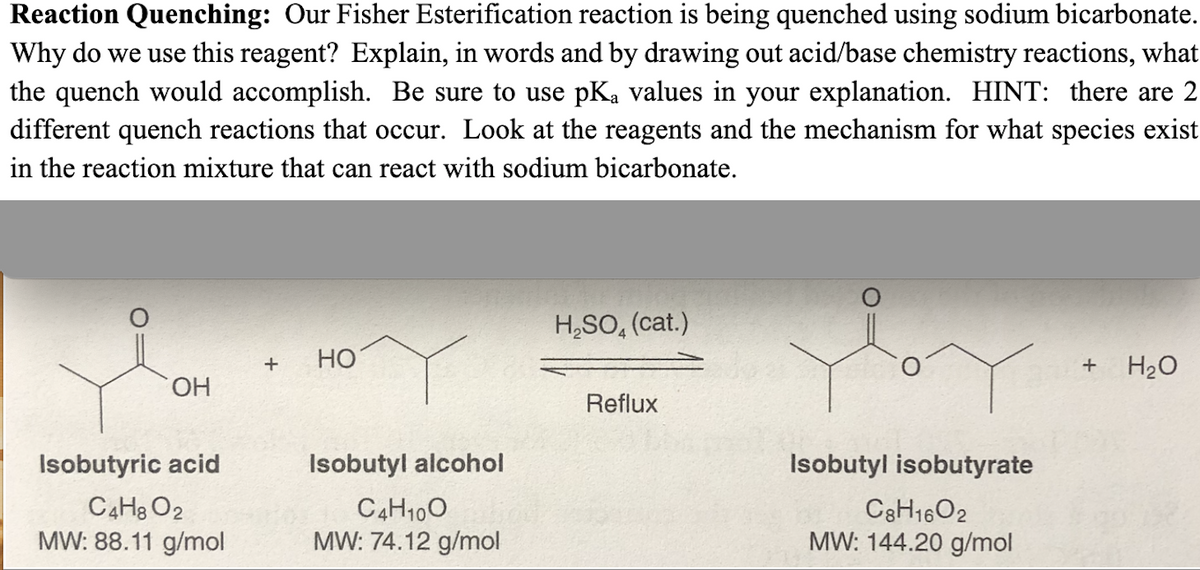Reaction Quenching: Our Fisher Esterification reaction is being quenched using sodium bicarbonate Why do we use this reagent? Explain, in words and by drawing out acid/base chemistry reactions, wha the quench would accomplish. Be sure to use pKą values in your explanation. HINT: there are 2 different quench reactions that occur. Look at the reagents and the mechanism for what species exis in the reaction mixture that can react with sodium bicarbonate. OH Isobutyric acid C4H8 02 MW: 88.11 g/mol + HO Isobutyl alcohol C4H10O MW: 74.12 g/mol H₂SO4 (cat.) Reflux O Isobutyl isobutyrate C8H1602 MW: 144.20 g/mol + H₂O
Reaction Quenching: Our Fisher Esterification reaction is being quenched using sodium bicarbonate Why do we use this reagent? Explain, in words and by drawing out acid/base chemistry reactions, wha the quench would accomplish. Be sure to use pKą values in your explanation. HINT: there are 2 different quench reactions that occur. Look at the reagents and the mechanism for what species exis in the reaction mixture that can react with sodium bicarbonate. OH Isobutyric acid C4H8 02 MW: 88.11 g/mol + HO Isobutyl alcohol C4H10O MW: 74.12 g/mol H₂SO4 (cat.) Reflux O Isobutyl isobutyrate C8H1602 MW: 144.20 g/mol + H₂O
Organic Chemistry: A Guided Inquiry
2nd Edition
ISBN:9780618974122
Author:Andrei Straumanis
Publisher:Andrei Straumanis
Chapter13: Substitution
Section: Chapter Questions
Problem 4E
Related questions
Question

Transcribed Image Text:Reaction Quenching: Our Fisher Esterification reaction is being quenched using sodium bicarbonate.
Why do we use this reagent? Explain, in words and by drawing out acid/base chemistry reactions, what
the quench would accomplish. Be sure to use pKa values in your explanation. HINT: there are 2
different quench reactions that occur. Look at the reagents and the mechanism for what species exist
in the reaction mixture that can react with sodium bicarbonate.
OH
Isobutyric acid
C4H8 02
MW: 88.11 g/mol
+ HO
Isobutyl alcohol
C4H10O
MW: 74.12 g/mol
H₂SO, (cat.)
Reflux
Isobutyl isobutyrate
C8H1602
MW: 144.20 g/mol
+ H₂O
Expert Solution
This question has been solved!
Explore an expertly crafted, step-by-step solution for a thorough understanding of key concepts.
This is a popular solution!
Trending now
This is a popular solution!
Step by step
Solved in 2 steps

Knowledge Booster
Learn more about
Need a deep-dive on the concept behind this application? Look no further. Learn more about this topic, chemistry and related others by exploring similar questions and additional content below.Recommended textbooks for you

Organic Chemistry: A Guided Inquiry
Chemistry
ISBN:
9780618974122
Author:
Andrei Straumanis
Publisher:
Cengage Learning

Organic Chemistry: A Guided Inquiry
Chemistry
ISBN:
9780618974122
Author:
Andrei Straumanis
Publisher:
Cengage Learning